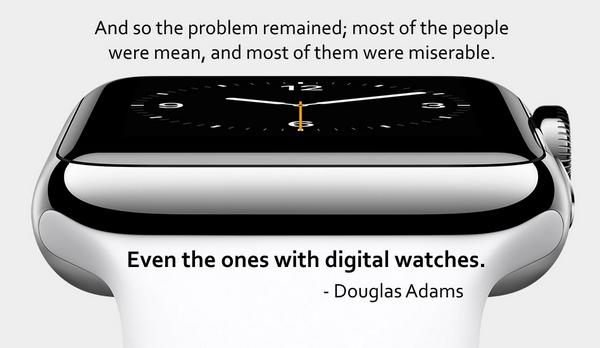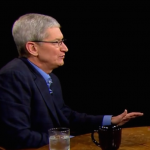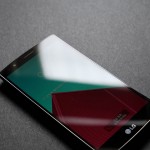
I am skeptical of the Apple Watch, in a way I haven’t been of an Apple product in a very long time. From the moment the concept of the smartwatch became the prime topic of tech conversation a couple of years ago, I failed to see what problem these devices could possibly solve. Certainly, smartwatches generally have some utility, and can make some things easier here and there, but it never struck me that these conveniences warranted an entirely separate, expensive gadget.
Apple’s watch, while really a lovely device, doesn’t appear to me to have transcended this. It’s clearly gorgeously designed as a piece of hardware –I’ve never been so enamored of a strap before, and the simplicity and elegance of the Apple Watch’s strap options are a subtle example of Apple at its best.1 Its use of the crown (the knob on the side) for navigation is highly clever and novel. Its communications abilities, with wispy doodles and broadcastable heartbeats, are very well considered and just look like a lot of fun.
But.
Apart from the hardware design, its overall execution seems to lean too heavily on “neat tricks” and cleverness for its own sake. Apple clearly made a real leap forward in figuring out how to execute a smartwatch. I don’t think they thought enough about why you’d need one at all. As Ben Thompson noted after the device’s unveiling, “We never got an explanation of why the Apple Watch existed, or what need it is supposed to fill.” (Check out my podcast discussion of the Apple event here.)
Now, I was rather skeptical of the iPad when it was first introduced in 2010. It looked like a lot of fun, but something that no one really needed, as its functions were already covered by iPhones and laptops. And if you already had a Kindle, too, well, forget it.
But boy did I come around on that one.2
As with my current feelings about the Apple Watch (which, I should note, is something I have of course not held or used), I struggled in 2010 to understand what problem the iPad was meant to solve. Thanks to Marco Arment bringing it up in a recent post of his, you can look back to John Gruber’s 2009 musings on the then-under-wraps iPad (known only as “The Tablet”) before anyone had seen one, and see that he was in the same place:
How much room is there between an iPhone (or iPod Touch) and a MacBook (or other laptop computer, running Windows or Linux or whatever)? What’s the argument for owning all three? “I’d use it on the couch and lying in bed” is not a good answer. You can already use your iPhone or MacBook on the couch and in bed. It strikes me as foolish to market a multi-hundred-dollar device that people are expected to leave on their coffee table.
But he also got the answer to that question right3:
Like all Apple products, The Tablet will do less than we expect but the things it does do, it will do insanely well. It will offer a fraction of the functionality of a MacBook — but that fraction will be way more fun.
Correct. You can’t do half the things on an iPad that you can on a MacBook, but some of those things that you can do are so much nicer on an iPad that the category thereby justifies itself many times over.
So here am I, trying to apply this wisdom to the Watch. Almost no one has used one in real life outside of Apple itself, but we’ve at least seen the thing now, unlike Gruber and the then-hypothetical tablet. So we know what it can do. What remains unclear to me, even after the introductory event, is what it’s supposed to do.
Maybe that doesn’t matter. Maybe it’s enough that it exists as a luxury techno-bauble that adds a little bit of convenience and glitz to some of the tasks usually reserved for phones, and that’s enough. But that’s not how it was pitched this week. Tim Cook called its introduction a “new chapter” for Apple, as though the company was presenting a device whose significance is on par with the iPhone and the Mac. So it’s not enough, in the Grand Apple Story, for it to be merely a clever trinket.
To be more than this, it will have to prove that, like the iPad, it performs its few functions “insanely well.” Perhaps it does. Though I’m even skeptical about that, for, as clever as the digital crown is as a means of navigation, the watch still requires a great deal of touch interaction. And every such interaction blocks out the entire screen.
And I truly wonder if a general consumer will have any idea how to get around from app to app, or discover how to navigate individual apps. Unlike the highly-intuitive iOS devices, there are no software buttons, no text labels, no obvious pointers to how to navigate the system. It’s all swipes and taps and, now, presses, none of them obvious. Again, the way Apple has gone about executing on the smartwatch concept is brilliant in and of itself; it’s truly astounding to me how much thought must have gone into each detail. But why?
When Microsoft first tried to make tablets, they took Windows and put it on a screen that would respond to a stylus, and in a laptop case that could flip its keyboard around, and no one wanted these. The category seemed dead, until the iPad gave the lie to Microsoft’s approach. In a much, much shorter space of time, Apple’s perceived role here was to likewise show up Android Wear, Galaxy Gear, and Pebble by creating the same category of device, but by picking and choosing functionality, and surpassing on those few areas. Instead, it seems to me that it’s Android Wear and Pebble that have the right idea, by emphasizing at-a-glance, contextually useful information, and Apple that’s trying to smush too much smartphone capability into a tiny rectangle. (For example: A wall of photo thumbnails? Is one supposed to carry around a microscope?)
I may be missing something big, and I welcome the opportunity to be shown the light. The iPhone, the Mac, the iPod, these things were obviously monumental from the moment they appeared, immediately justifying their place in our lives. The iPad took a little more convincing, but the benefit of the doubt it was given has paid off in spades. Perhaps it will be so for the Apple Watch, and it will this was something Apple didn’t just make because it had to.
Notes:
1. I’m also thinking of things like the sleep indicator light on MacBooks that seem to “breathe” as the machine snoozes, or the magnetic hook that held the old titanium and aluminum PowerBooks lids closed, which disappeared into the chassis when the lid was opened.
2. Interestingly, while a came full circle to being a huge iPad booster, in recent months I’ve used it less and less as, wouldn’t you know it, MacBooks have become more portable and “fun” to use, brining with them all the raw functionality they’d always had.
3. Interesting bit that Gruber got wrong. In his prediction piece, he wrote:
One common prediction I disagree with is that The Tablet will simply be more or less an iPod Touch with a much bigger display. But in the same way that it made no sense for Apple to design the iPhone OS to run Mac software, it makes little sense for a device with a 7-inch (let alone larger) display to run software designed for a 3.5-inch display. … If Apple’s starting with a hardware size where the iPhone OS can’t be used one-handed, then trust me, they’re designing a new interaction model.
Oops. While the iPad does have apps that taylor themselves to its screen size, it does, in fact, to this day, run for all intents and purposes the same exact operating system with the same UI as the iPhone. No one can be right all the time.















